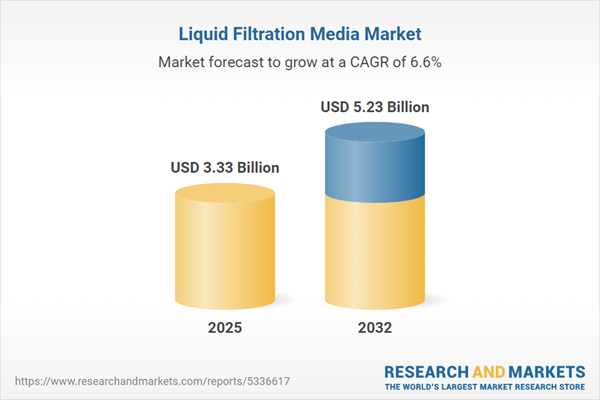Speak directly to the analyst to clarify any post sales queries you may have.
Amid shifting regulatory standards and advancing industrial requirements, the liquid filtration media market is evolving to meet more complex operational, sustainability, and quality demands. Senior decision-makers navigating this landscape benefit from understanding how new technologies, material innovations, and global trade shifts are reshaping purification strategies across critical sectors.
Market Snapshot: Liquid Filtration Media Market Overview
The liquid filtration media market is witnessing steady expansion, with recent growth from USD 3.13 billion in 2024 to USD 3.33 billion in 2025, and projected to reach USD 5.23 billion by 2032 at a CAGR of 6.63%. This momentum is driven by heightened quality expectations in pharmaceuticals, food and beverage, and water treatment, as well as the integration of advanced membranes and filtration formats to optimize performance and resource use. Regulatory compliance, process stability, and sustainability remain primary drivers for investment in upgraded filtration solutions.
Scope & Segmentation
This comprehensive report delivers a deep examination of the liquid filtration media sector, supporting decision-makers in identifying key opportunities across the following segments and regions:
- Application Areas: Chemicals and Petrochemicals, Food and Beverage, Oil and Gas, Pharmaceuticals, Power Generation, Pulp and Paper, Water and Wastewater Treatment
- Material Types: Ceramic, Metal, Polyethersulfone, Polypropylene, Polytetrafluoroethylene, Polyvinylidene Fluoride
- Filter Formats: Bag, Cartridge (Single Open End, Double Open End), Hollow Fiber, Plate and Frame, Pleated, Spiral Wound, Tubular
- Filtration Mechanisms: Adsorption, Cross Flow, Depth, Surface
- Regions: Americas (including United States, Canada, Mexico, Brazil, Argentina, Chile, Colombia, Peru), Europe (United Kingdom, Germany, France, Russia, Italy, Spain, Netherlands, Sweden, Poland, Switzerland), Middle East (United Arab Emirates, Saudi Arabia, Qatar, Turkey, Israel), Africa (South Africa, Nigeria, Egypt, Kenya), Asia-Pacific (China, India, Japan, Australia, South Korea, Indonesia, Thailand, Malaysia, Singapore, Taiwan)
- Leading Companies: 3M Company, Parker-Hannifin Corporation, Donaldson Company Inc., Eaton Corporation plc, Danaher Corporation, DuPont de Nemours Inc., MANN+HUMMEL GmbH, Freudenberg SE, Ahlstrom-Munksjö Oyj, Pentair plc
Key Takeaways for Senior Decision-Makers
- Adoption of advanced polymers and hybrid ceramic composites is enabling manufacturers to meet higher efficiency and durability requirements while managing lifecycle costs.
- Increased regulatory scrutiny is accelerating the shift toward recyclable and regenerable filtration media, with enterprises prioritizing formats that reduce waste and align with extended responsibility mandates.
- Digitalization through IoT sensors and cloud analytics allows operators to predict maintenance needs and optimize change-out cycles, solving cost and downtime challenges.
- Regional differences are shaping procurement choices, as established economies focus on circular economy initiatives and emerging economies drive new demand in pharmaceuticals and municipal water treatment.
- Strategic alliances between filtration companies and equipment integrators are resulting in end-to-end solutions, simplifying installation and facilitating rapid deployment across diverse industries.
Tariff Impact and Supply Chain Resilience
Recent changes in United States tariff policies targeting key imported filtration components have altered cost dynamics and supply chain strategies. Some suppliers are increasing domestic production or exploring alternative materials to mitigate these cost shifts, while buyers are seeking flexible procurement agreements. These changes are reinforcing the value of nearshoring and dual-sourcing strategies to sustain uninterrupted supply and maintain competitiveness.
Research Methodology & Data Sources
The study employs a blend of secondary data from journals, regulatory reports, and industry publications, combined with primary research via interviews with stakeholders including engineers, procurement managers, and compliance experts. Quantitative surveys and cross-validation techniques underpin key findings, ensuring robust and actionable insights specific to filtration media.
Why This Report Matters
- Enables senior leaders to benchmark against competitors and identify strategic growth areas by segment, region, and technology.
- Provides clarity on regulatory and policy shifts allowing for forward-looking risk management and procurement optimization.
- Highlights the impact of digitization and sustainability expectations, empowering informed investment in next-generation filtration solutions.
Conclusion
This report guides decision-makers through the complexities of the liquid filtration media market, emphasizing actionable insights on innovation, supply chain resilience, and regulatory adaptation. Understanding these dynamics will support sustainable growth and stronger competitive positioning in a rapidly transforming landscape.
Additional Product Information:
- Purchase of this report includes 1 year online access with quarterly updates.
- This report can be updated on request. Please contact our Customer Experience team using the Ask a Question widget on our website.
Table of Contents
3. Executive Summary
4. Market Overview
7. Cumulative Impact of Artificial Intelligence 2025
Companies Mentioned
The companies profiled in this Liquid Filtration Media market report include:- 3M Company
- Parker-Hannifin Corporation
- Donaldson Company, Inc.
- Eaton Corporation plc
- Danaher Corporation
- DuPont de Nemours, Inc.
- MANN+HUMMEL GmbH
- Freudenberg SE
- Ahlstrom-Munksjö Oyj
- Pentair plc
Table Information
| Report Attribute | Details |
|---|---|
| No. of Pages | 193 |
| Published | November 2025 |
| Forecast Period | 2025 - 2032 |
| Estimated Market Value ( USD | $ 3.33 Billion |
| Forecasted Market Value ( USD | $ 5.23 Billion |
| Compound Annual Growth Rate | 6.6% |
| Regions Covered | Global |
| No. of Companies Mentioned | 11 |









